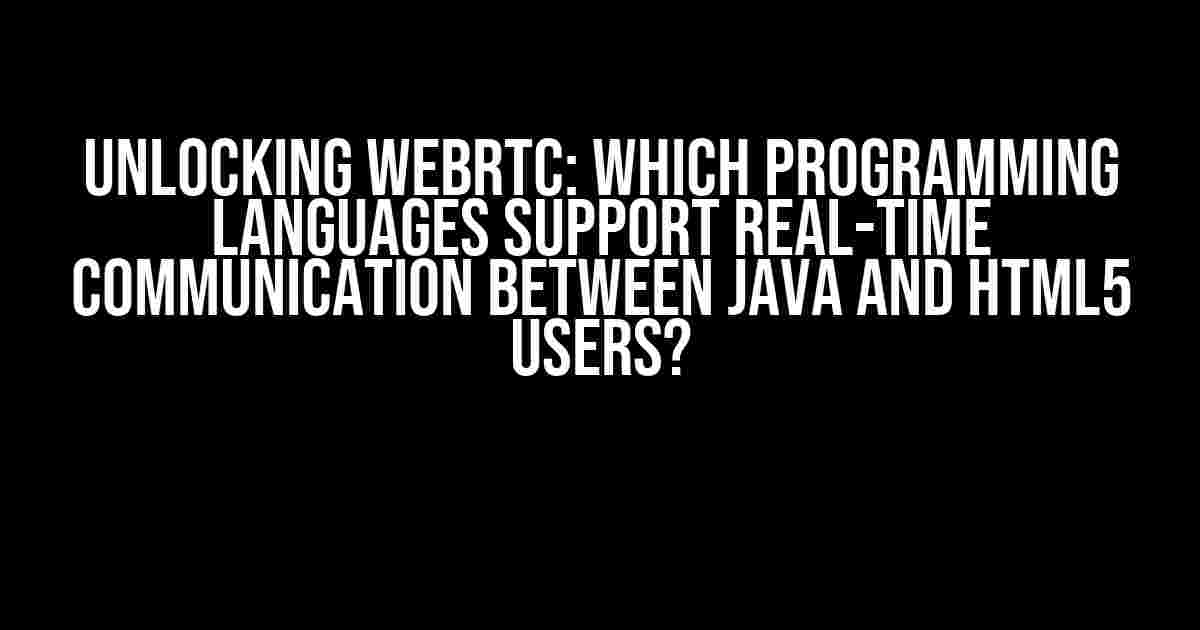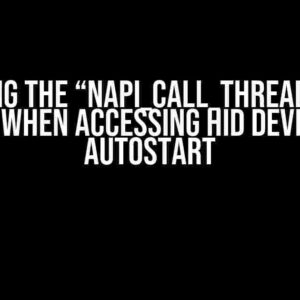Imagine a world where users can communicate in real-time, regardless of the platform or device they’re using. Welcome to the world of WebRTC (Web Real-Time Communication)! In this article, we’ll explore the programming languages that support WebRTC between a Java user and an HTML5 user, and provide a comprehensive guide on how to get started.
What is WebRTC?
WebRTC is an open-source project that enables real-time communication between browsers, mobile apps, and desktop applications. It provides a set of APIs (Application Programming Interfaces) and protocols for building peer-to-peer applications, allowing users to communicate via voice, video, and data channels.
Key Features of WebRTC
- Peer-to-peer connectivity: No need for servers or relays
- Real-time communication: Instant messaging, voice, and video calls
- Multimedia support: Audio, video, and data channels
- Cross-platform compatibility: Works on multiple devices and platforms
Java and WebRTC: A Match Made in Heaven
Java, being a widely-used programming language, has excellent support for WebRTC. Developers can use Java to build WebRTC applications that communicate with HTML5 users. To get started, you’ll need to use a Java WebRTC library that provides the necessary APIs and tools.
Popular Java WebRTC Libraries
- Vert.x: A popular, open-source framework for building real-time applications
- Kurento Media Server: A Java-based media server for building WebRTC applications
- Jitsi Videobridge: A Java-based video conferencing platform
HTML5 and WebRTC: A Perfect Pair
HTML5, being the latest version of the HTML standard, provides built-in support for WebRTC. Developers can use HTML5, CSS, and JavaScript to build WebRTC applications that communicate with Java users. To get started, you’ll need to use the WebRTC APIs and tools provided by the browser or a JavaScript library.
Popular HTML5 WebRTC Libraries
- SimpleWebRTC: A lightweight JavaScript library for building WebRTC applications
- PeerJS: A JavaScript library for building peer-to-peer applications
- WebRTC.io: A JavaScript library for building real-time communication applications
Which Programming Languages Support WebRTC?
Besides Java and HTML5, several other programming languages support WebRTC. Here are a few examples:
| Language | WebRTC Support |
|---|---|
| Python | Aiortc, PyWebRTC, and others |
| C++ | Native WebRTC implementation, webrtc.org |
| Node.js | Socket.io, ws, and others |
| Ruby | WebRTC-Ruby, webrtc-ruby, and others |
Building a WebRTC Application with Java and HTML5
Now that we’ve covered the basics, let’s build a simple WebRTC application using Java and HTML5. We’ll use Vert.x as our Java WebRTC library and SimpleWebRTC as our HTML5 WebRTC library.
Java Side: Setting up Vert.x
// Maven dependency for Vert.x
<dependency>
<groupId>io.vertx</groupId>
<artifactId>vertx-web</artifactId>
<version>3.9.5</version>
</dependency>
// Creating a Vert.x instance
Vertx vertx = Vertx.vertx();
// Creating a WebRTC peer connection
PeerConnection pc = new PeerConnection(vertx);
// Setting up the peer connection
pc.setRemoteDescription(new Offer(" offer"));
pc.setLocalDescription(new Answer(" answer"));
HTML5 Side: Setting up SimpleWebRTC
// Including SimpleWebRTC library
<script src="https://cdn.jsdelivr.net/npm/simplewebrtc@latest/simplewebrtc.min.js"></script>
// Creating a SimpleWebRTC instance
var webrtc = new SimpleWebRTC({
// Setting up the peer connection
peerConnectionConfig: {
iceServers: [{"urls": "stun:stun.l.google.com:19302"}]
}
});
// Creating a video element
var video = document.getElementById("video");
// Adding an event listener for the peer connection
webrtc.on("stream", function(stream) {
// Adding the stream to the video element
video.srcObject = stream;
});
Conclusion
That’s it! We’ve explored the world of WebRTC and the programming languages that support it. By using Java and HTML5, we can build powerful WebRTC applications that enable real-time communication between users. Remember to choose the right WebRTC library for your needs, and don’t hesitate to experiment with different programming languages and tools.
Best Practices for WebRTC Development
- Choose the right WebRTC library for your needs
- Use secure protocols and encryption
- Test your application extensively
- Optimize for performance and scalability
Final Thoughts
WebRTC has the potential to revolutionize the way we communicate online. By understanding the programming languages that support WebRTC, we can build innovative applications that bridge the gap between different platforms and users. So, what are you waiting for? Start building your WebRTC application today and unlock the power of real-time communication!
Frequently Asked Question
Unlocking the power of WebRTC, we dive into the world of programming languages that support seamless communication between a Java user and a browser HTML5 user.
What programming language can facilitate real-time communication between a Java user and a browser HTML5 user using WebRTC?
Java, when used with libraries like Java WebRTC or SimpleWebRTC, can effortlessly establish peer-to-peer connections with browser HTML5 users, enabling real-time communication and data exchange.
Can Python be used as a bridge to connect a Java user with a browser HTML5 user via WebRTC?
Yes, Python can act as a bridge! By using libraries like aiortc, PyWebRTC, or Pion, Python can establish a signaling server, enabling communication between the Java user and the browser HTML5 user through WebRTC.
Is it possible to use Node.js as a WebRTC signaling server to facilitate communication between a Java user and a browser HTML5 user?
Absolutely! Node.js, with libraries like Socket.IO or SimpleWebRTC, can efficiently act as a signaling server, allowing the Java user and the browser HTML5 user to exchange data and communicate in real-time using WebRTC.
Can C# be used to develop a WebRTC application that connects a Java user with a browser HTML5 user?
Yes, C# can be used! By leveraging libraries like CSWebRTC or Itcop, C# can develop a WebRTC application that enables seamless communication and data exchange between the Java user and the browser HTML5 user.
What about Go? Can it be used to develop a WebRTC application that connects a Java user with a browser HTML5 user?
Go, also known as Golang, can be used to develop a WebRTC application! With libraries like Pion or Gorilla, Go can efficiently establish peer-to-peer connections, enabling real-time communication and data exchange between the Java user and the browser HTML5 user.






